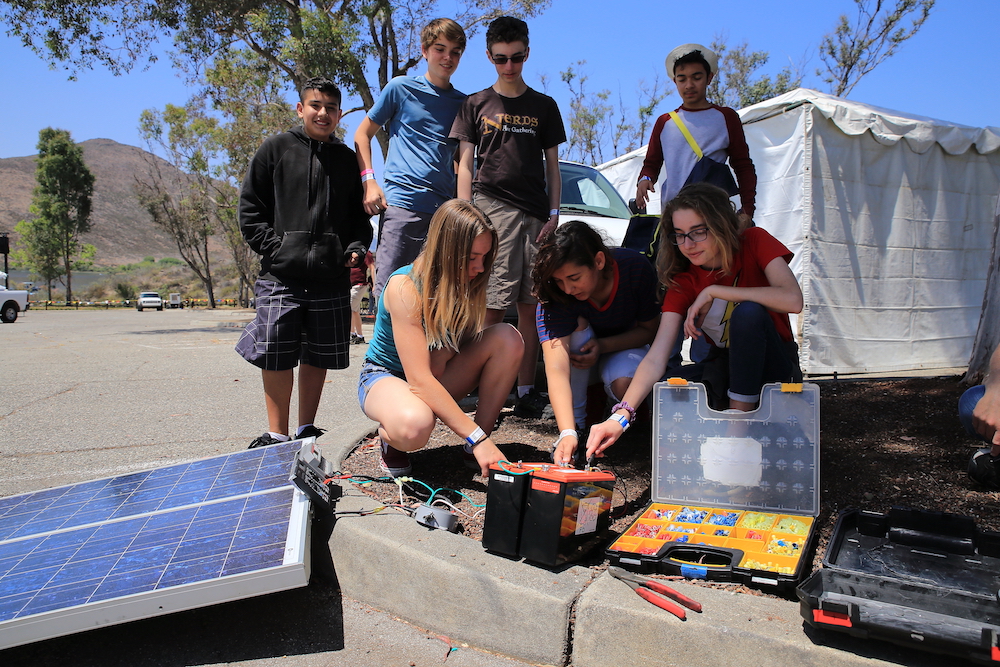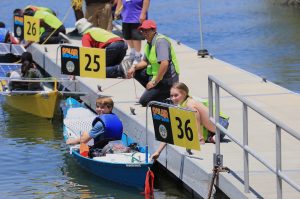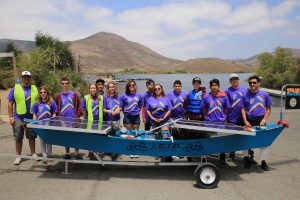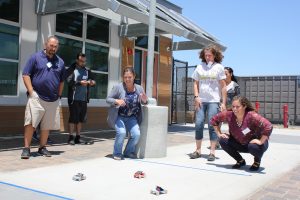By. Nicole Grucky, Project Coordinator, Strategic Energy Innovations
Kearny High School’s School of Engineering, Innovation, and Design (EID) in San Diego, California has partnered with environmental nonprofit Strategic Energy Innovations (SEI) since 2013 to infuse sustainability into its classes. Through this educational approach, students gain a sense of environmental stewardship and global awareness while exploring green and blue technology careers in the engineering and architecture pathways. Leading this effort at Kearny is a grade level interdisciplinary team that includes Jessica Fritchel (Social Studies and English Language for ninth-, tenth-, and twelfth-grades), Daniel Robles (Introduction to Design and Environmental Engineering for ninth-grade), and Monica Carapia (Math Integrated I and II for ninth-grade).
“At the very core of our hearts at EID is that none of the other content, curriculum, or projects matter if we don’t leave behind a sustainable community and planet for future generations.” — Jessica Frichtel
EID prepares students to address real-world environmental and social issues in the community through a Linked Learning approach. Interdisciplinary projects, or Linked Learning as Kearny calls it, allows students to see the crossover of content when trying to solve problems in a complex world. With many problems to solve, students need to be able to pull from any or all content areas to be successful.
One class that exemplifies the Linked Learning approach is Environmental Engineering, which is now one of Kearny’s core class offerings. The course utilizes lessons from SEI’s Introduction to Green Technology course on climate change science, biomimicry, energy auditing, energy conservation action planning, wind turbine design, solar car design and build, biodiesel, and climate protection policy plans.
Kearny teachers recognize that to get students to buy-in to the work they are doing, they must be able to answer the question “what’s in it for me?” A key component of Kearny’s success to integrating SEI’s Introduction to Green Technology course in their Environmental Engineering class is centered around the launch of the curriculum and projects. When Kearny launches the curriculum, teachers highlight how in the real world, students will be able to earn money and engage in a career conducting energy audits or testing water quality based on the skills they are about to learn. This framing gives relevancy to the students’ work.
“When we respect them enough and have high enough expectations to facilitate authentic challenges and teach them marketable skills then the benefit for them becomes obvious.” — Jessica Frichtel
Students appreciate and value learning about energy conservation and solar installation because they can apply that learning at home and reap the benefits. Those are the activities that students love. While students learn about solar installations in the classroom, they also get to see it in-person and even lend a hand in the field. In previous years, SEI has planned a tour of the University of California, San Diego micro-grid for students where they learned about solar photovoltaic systems, electric vehicle charging, and energy storage.
In 2018, SEI facilitated a collaboration between ninth-grade engineering students as part of an extension of the SEI Solar Certificate and Introduction to Green Technology solar projects. As a creative expansion of the Solar Certificate curriculum, groups of Kearny students worked together to design a solar boat for the Metropolitan Water District of Southern California Solar Cup. To compete in the Solar Cup, students had to create a Public Service Announcement (PSA), perform sophisticated technical writing to draft their engineering design rationale, and use on-demand math skills to figure the input versus output of energy, all of which align with state standards.
The Kearny team came in second out of 39 rookie teams from Southern California. Afterward, each student designed their own small boat to race at the school’s campus.
“One of the most memorable parts of the project was having that shared experience with the students participating in the Solar Cup. Camping for an entire weekend at Lake Skinner in Temecula, working on the boat and troubleshooting on-site, and getting to know our students more in-depth outside of the academic setting. When we asked them what was their favorite part of freshmen year, those same students said having participated in the Solar Cup. Most of the teams that participated consisted of upperclassmen students. We had all freshmen students and were able to take a medal home. All their hard work was recognized not only in the Solar Cup competition but also in the CCTE Showcase and San Diego County Fair Student Exhibition.” — Daniel Robles and Monica Carapia
Environmental Engineering students also participated in SEI’s Earth Day Campaign Contest. This was a way for students to influence the greater student body. For the most effective campus campaign, students read an article about neuroscience to understand how to make a longer-lasting impact that was in alignment with brain research. They found that long-term behavioral changes are difficult to establish, so they decided to focus their efforts on what methods would be most efficient. After students worked with San Diego Unified School District to get Kearny’s water, energy, and waste data, they came up with several different approaches to educate their fellow students and encourage them to make cultural changes. These included creating posters and PSAs and going to classrooms to present the data and their goals.
Truly, the Linked Learning method is working for Kearny! Over the duration of the Environmental Engineering course and other sustainability focused courses offered at Kearney, students have seen a 78.9% increase in knowledge as evaluated from average test scores on pre- and post-course tests. This is just the beginning. Kearny continues to instill sustainability throughout its courses and is working with SEI to develop an interdisciplinary project in their economics and engineering and physics classes focused on micro-grids and energy storage for communities and college campuses.
If you are looking to integrate sustainability in your classroom, Kearny’s interdisciplinary teacher team recommends “encourage students to be ignorant to the limit of their skill abilities when working on a project and create a safe place for them to explore their potential. They will blow away the highest expectations you could ever dream of!”
**********
SEI offers two courses, Introduction to Green Technology and Energy and Environmental Design, that are designed to meet California Career Technical Education Standards of the Energy, Environment, and Utilities sector. Both are year-long UC A-G approved courses, D-Lab Science and G-Elective, respectively. These courses are project-based and Common Core and Next Generation Science Standard-aligned.
SEI’s Introduction to Green Technology course introduces students to career opportunities and skills in sustainable STEM fields using a series of hands-on, applied projects including: carbon footprint analysis, home energy use analysis, building a mini generator, residential circuit construction, school energy auditing, wind turbine design, solar car design/build, building a solar USB (phone) charger, making biodiesel, and design and construction of a model residential building to LEED standards.
In SEI’s Energy and Environmental Design course, students complete more in-depth projects related to sustainable design, energy efficiency, and renewable energy. This includes a project centered on developing a Zero Net Energy plan for their school comprised of utility bill analysis, an energy conservation action plan, energy audit report with recommendations, and a school solar design project aimed at offsetting energy use. Students also participate in ground-mounted and residential rooftop system design and installation; aquaponics system design, build, and cultivation; solar hot water system design and build; and a capstone biomimicry energy and climate design competition.
If you are interested in the Introduction to Green Technology or Energy and Environmental Design courses, or any other sustainability-related courses, visit https://www.seiinc.org/programs/eco-smart-schools/k-12/390-curriculum to learn more. If you are interested in learning how you can incorporate sustainability curriculum into your courses, email us at energizeschools@seiinc.org.
Author Bio
Nicole Grucky is a Project Coordinator at the environmental nonprofit SEI, where she oversees communications and provides programmatic support to education and workforce development projects. Prior to joining SEI, Nicole was a Program Coordinator at the environmental education nonprofit Grades of Green where she mentored middle school students implementing green projects, assisted schools implementing a trash reduction program, and created monthly newsletters. Working in the communications sector within the environmental field, she is passionate about climate change communication and inspiring people to change their behaviors.





